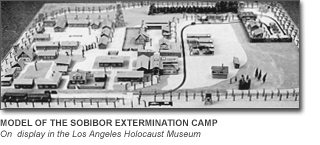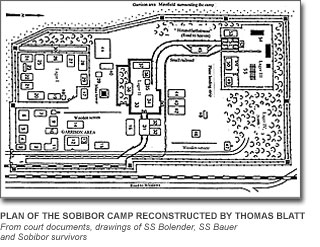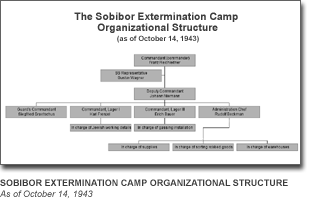|
| ||||||||
 |
|

The Sobibor camp was located three miles from the Bug River in a sparsely populated area in the eastern part of occupied Poland, near the village of Sobibor, between the cities of Chelm and Wlodawa. The initial 30 acres of camp territory was later expanded to 145 acres.
Camp security was crucial to the death camp. At Sobibor it included an excellent lighting system in and around the camp which had an independent electric aggregate, multiple barbed wire fences intertwined with young pine branches to conceal the interior. Besides the main observation tower in the middle of the camp, a series of smaller guard towers surrounded Sobibor. Added to the security was a 15 meter-wide minefield around the perimeter.
The interior of the camp was divided into five main sections: "Vorlager" or garrison area and four inner sections called Lagers: II, III, IV and I. Separately partitioned with barbed wire fence these were, in essence, cages within cages. A brief description reveals both their relationship to one another and their separate functions.
 Click to Enlarge Details (30K) |
The GARRISON AREA included the main entrance gates, the extension rail from the main outside depot and the railway platform where the victims were taken off the trains. The Commander's villa "Swallows' Nest" stood opposite the platform and was flanked on the right by the guardhouse and on the left by the armory. The SS villa known as "The Happy Flea", as well as additional SS quarters, garage, mess hall and other buildings were built nearby. The barracks of the Ukrainian guards' were located just to the north, opposite the fence.
LAGER I was built directly west and behind the garrison area. It was made escape proof by extra barbed wire fences and a deep trench filled with water. The only opening was a gate leading into the garrison area. This Lager was the living barracks for Jewish prisoners and included a prisoner's kitchen. Each prisoner was given approximately twelve square feet of sleeping space. The women prisoners slept in a separate barrack.
Jews employed in Lager I provided services for the Nazi staff: tailors and shoemakers, shops for carpentry, mechanical and other maintenance needs. After work, the Jewish prisoners from throughout the camp (except Lager III) were assembled in Lager I for roll call and night lock-ups.
LAGER II was a larger section and included a variety of essential "services" for both the killing process and the everyday operation of the camp. Worked by 400 prisoners, including women, Lager II contained the warehouses used for storing the articles taken from the dead victims, including hair, clothes, food, gold and all other valuables. This Lager also housed the main administration office.
It was at Lager II that the Jews were "greeted" and prepared for their death. Here they undressed, women's hair was shorn, clothing searched and sorted and documents destroyed in the nearby incinerator. The victim's final steps were taken on a sandy pathway 164 yards long and about 10 feet wide framed by barbwire. Cynically called "Himmelfahrtstrasse" (Heavenly Way), it led directly to the gas chambers.
LAGER III was where the victims met their end. Located in the northwestern part of the camp, there were only two ways to enter the camp from Lager II. The camp staff and personnel entered through a small nondescript gate. The entrance for the victims was also the place of their earthly exit; it descended immediately into the gas chambers decorated with flowers and a Star of David. The structures there included (besides the gas chamber and the open-air crematorium) a special cage like enclosure for the 150 Jewish prisoners working there.
The camp was constantly rebuilt and expanded. The chambers, no longer large enough to handle the large waves of victims, were demolished in August, 1942 and a new massive building with about twice the number of gassing units was built. A long corridor two yards wide led to the gas chambers with the inscription "Bathhouse". These new gas chambers were 4.40 yards by 4.40 yards and 2.42 yards high. The victims entered the gas chambers trough small doors; they exited through large swinging doors that led to 32 inch-high ramps, making it easier to unload their bodies. Tightly packed, one chamber held 450-500 people. The engine that generated the deadly carbon monoxide was in a small shed adjacent to the gas chambers.
The Nazi staff was sent from the discontinued (due to the outcry of the church) Euthanasia program in Germany. It included the first commander of Sobibor, SS-Hauptsturmfuehrer Franz Stangl, who later in August,1942 was replaced with SS-Hauptsturmfuehrer Franz Reichleitner and a group of 30 non-commissioned officers of which about half was always rotating on special leave. A force of about 120 Ukrainians were always on guard duty.
The Jewish prisoners accounted for a total of close to 650 men, including about 100 women and 150 prisoners separated in Lager III.
 Click to Enlarge Details (16K) |